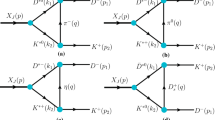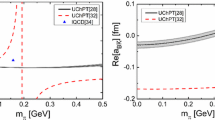Abstract
In 2019, two new structures \(\Lambda _b(6146)\) and \(\Lambda _b(6152)\) were observed by the LHCb Collaboration at the invariant mass spectrum of \(\Lambda _b^0\pi ^{+}\pi ^{-}\), which aroused a hot discussion about their inner structures. The \(\Lambda _b(6146)\) and \(\Lambda _b(6152)\) might still be molecular states because their masses are close to threshold of a \(\bar{B}\) meson and a nucleon. In this work, we perform a systematical investigation of possible heavy baryonic molecular states from the \(\bar{B}N\) interaction. Since the \(\bar{B}N\) channel strongly couples to the \(\bar{B}^{*}N\) channel, the possible \(\bar{B}N{-}\bar{B}^{*}N\) bound states are also studied. The interaction of the system considered is described by the t-channel \(\sigma \), \(\pi \), \(\eta \),\(\omega \), and \(\rho \) mesons exchanges. By solving the non-relativistic Schrödinger equation with the obtained one-boson-exchange potentials, the \(\bar{B}^{(*)}N\) bound states with different quantum numbers are searched. The calculation suggests that recently observed \(\Lambda _b(6146)\) can be assigned as a P-wave \(\bar{B}N\) molecular state with spin parity \(J^P=3/2^{+}\) or a \(\bar{B}N{-}\bar{B}^{*}N\) bound state. However, assignment of \(\Lambda _b(6152)\) as an F-wave \(\bar{B}N\) molecular is disfavored. The \(\Lambda _b(6152)\) can be explained as meson–baryon molecular state with a small \(\bar{B}N\) component. The calculation also predict the existence of two \(\bar{B}N{-}\bar{B}^{*}N\) bound states with \(J^P=1/2^{-}\) and \(J^P=3/2^{-}\).




Similar content being viewed by others
Data Availability Statement
This manuscript has no associated data or the data will not be deposited. [Authors’ comment: All the relevant data are already contained in the manuscript.]
Notes
In Ref. [23], the decay widths for \(\Lambda _b(6146)\rightarrow \Sigma ^{(*)}\pi \) were calculated as 4.18 MeV and for \(\Lambda _b(6152)\rightarrow \Sigma ^{(*)}\pi \) as 4.39 MeV, assuming \(\Lambda _b(6146)\) and \(\Lambda _b(6152)\) to be 3-quark states.
References
P.A. Zyla et al. [Particle Data Group], PTEP 2020, 083C01 (2020)
R. Aaij et al. [LHCb], Phys. Rev. Lett. 122, 222001 (2019)
R. Aaij et al. [LHCb], Sci. Bull. 66, 1278–1287 (2021)
C.J. Xiao, Y. Huang, Y.B. Dong, L.S. Geng, D.Y. Chen, Phys. Rev. D 100, 014022 (2019)
F. Yang, Y. Huang, H.Q. Zhu, Sci. China Phys. Mech. Astron. 64, 121011 (2021)
J. He, D.Y. Chen, Eur. Phys. J. C 79, 887 (2019)
E.Y. Paryev, Nucl. Phys. A 1023, 122452 (2022)
F.L. Wang, R. Chen, X. Liu, Phys. Rev. D 103, 034014 (2021)
J.T. Zhu, S.Y. Kong, Y. Liu, J. He, Eur. Phys. J. C 80, 1016 (2020)
K.L. Wang, Y.X. Yao, X.H. Zhong, Q. Zhao, Phys. Rev. D 96, 116016 (2017)
K. Gandhi, A. Kakadiya, Z. Shah, A.K. Rai, AIP Conf. Proc. 2220, 140015 (2020)
Y. Kawakami, M. Harada, Phys. Rev. D 99, 094016 (2019)
Y. Kawakami, M. Harada, Phys. Rev. D 97, 114024 (2018)
O. Romanets, C. Garcia-Recio, L.L. Salcedo, J. Nieves, L. Tolos, Acta Phys. Polon. Supp. 6, 973–978 (2013)
J.X. Lu, Y. Zhou, H.X. Chen, J.J. Xie, L.S. Geng, Phys. Rev. D 92, 014036 (2015)
W.H. Liang, C.W. Xiao, E. Oset, Phys. Rev. D 89, 054023 (2014)
C. Garcia-Recio, J. Nieves, O. Romanets, L.L. Salcedo, L. Tolos, Phys. Rev. D 87, 034032 (2013)
Y. Huang, H.Q. Zhu, Phys. Rev. D 104, 056027 (2021)
R. Aaij et al. [LHCb], Phys. Rev. Lett. 123, 152001 (2019)
A.M. Sirunyan et al. [CMS], Phys. Lett. B 803, 135345 (2020)
Q. Mao, H.X. Chen, H.M. Yang, Universe 6, 86 (2020)
K. Azizi, Y. Sarac, H. Sundu, Phys. Rev. D 101, 074026 (2020)
B. Chen, S.Q. Luo, X. Liu, T. Matsuki, Phys. Rev. D 100, 094032 (2019)
K.L. Wang, Q.F. Lü, X.H. Zhong, Phys. Rev. D 100, 114035 (2019)
W. Liang, Q.F. Lü, X.H. Zhong, Phys. Rev. D 100, 054013 (2019)
G.L. Yu, Z.G. Wang, X.W. Wang. arXiv:2109.02217 [hep-ph]
A. Kakadiya, Z. Shah, K. Gandhi, A.K. Rai. arXiv:2108.11062 [hep-ph]
T.F. Caramés, A. Valcarce, Phys. Rev. D 95, 094011 (2017)
B. Wang, L. Meng, S.L. Zhu, Phys. Rev. D 101, 094035 (2020)
H.Y. Cheng, C.Y. Cheung, G.L. Lin, Y.C. Lin, T.M. Yan, H.L. Yu, Phys. Rev. D 47, 1030–1042 (1993)
T.M. Yan, H.Y. Cheng, C.Y. Cheung, G.L. Lin, Y.C. Lin, H.L. Yu, Phys. Rev. D 46, 1148-1164 (1992). [erratum: Phys. Rev. D 55, 5851 (1997)]
M.B. Wise, Phys. Rev. D 45, R2188 (1992)
G. Burdman, J.F. Donoghue, Phys. Lett. B 280, 287–291 (1992)
R. Casalbuoni, A. Deandrea, N. Di Bartolomeo, R. Gatto, F. Feruglio, G. Nardulli, Phys. Rep. 281, 145–238 (1997)
A.F. Falk, M.E. Luke, Phys. Lett. B 292, 119–127 (1992)
C. Isola, M. Ladisa, G. Nardulli, P. Santorelli, Phys. Rev. D 68, 114001 (2003)
X. Liu, Z.G. Luo, Y.R. Liu, S.L. Zhu, Eur. Phys. J. C 61, 411–428 (2009)
R. Chen, Z.F. Sun, X. Liu, S.L. Zhu, Phys. Rev. D 100, 011502 (2019)
W.A. Bardeen, E.J. Eichten, C.T. Hill, Phys. Rev. D 68, 054024 (2003)
L. Zhao, L. Ma, S.L. Zhu, Phys. Rev. D 89, 094026 (2014)
E.J. Garzon, E. Oset, Eur. Phys. J. A 48, 5 (2012)
E. Oset, A. Ramos, Nucl. Phys. A 635, 99–120 (1998)
B. Borasoy, Phys. Rev. D 59, 054021 (1999)
V.G.J. Stoks, R.A.M. Klomp, C.P.F. Terheggen, J.J. de Swart, Phys. Rev. C 49, 2950–2962 (1994)
R. Machleidt, K. Holinde, C. Elster, Phys. Rep. 149, 1–89 (1987)
G. Breit, Phys. Rev. 34, 553–573 (1929)
G. Breit, Phys. Rev. 36, 383–397 (1930)
N. Yalikun, Y.H. Lin, F.K. Guo, Y. Kamiya, B.S. Zou, Phys. Rev. D 104, 094039 (2021)
L. Zhao, N. Li, S.L. Zhu, B.S. Zou, Phys. Rev. D 87, 054034 (2013)
Y. Dong, A. Faessler, T. Gutsche, Q. Lü, V.E. Lyubovitskij, Phys. Rev. D 96, 074027 (2017)
D.Y. Chen, X. Liu, T. Matsuki, Phys. Rev. D 87, 054006 (2013)
H. Xu, J.J. Xie, X. Liu, Eur. Phys. J. C 76, 192 (2016)
M. Ablikim et al. [BESIII], Phys. Rev. D 90, 032007 (2014)
X. Liu, B. Zhang, S.L. Zhu, Phys. Lett. B 645, 185–188 (2007)
P. Colangelo, F. De Fazio, T.N. Pham, Phys. Lett. B 542, 71–79 (2002)
C. Meng, K.T. Chao, Phys. Rev. D 75, 114002 (2007)
X. Liu, Z.T. Wei, X.Q. Li, Eur. Phys. J. C 59, 683–689 (2009)
L. Zhao, L. Ma, S.L. Zhu, Nucl. Phys. A 942, 18–38 (2015)
J. Binstock, R. Bryan, Phys. Rev. D 4, 1341–1352 (1971)
A. Calle Cordon, E. Ruiz Arriola, AIP Conf. Proc. 1030, 334–338 (2008)
M.J. Yan, F.Z. Peng, M. Sánchez Sánchez, M. Pavon Valderrama, Phys. Rev. D 104, 114025 (2021)
Y. Huang, Cj. Xiao, Q.F. Lü, R. Wang, J. He, L. Geng, Phys. Rev. D 97, 094013 (2018)
Y. Yamaguchi, S. Ohkoda, S. Yasui, A. Hosaka, Phys. Rev. D 87, 074019 (2013)
Acknowledgements
This work was supported by the National Natural Science Foundation of China under Grant no. 12104076, the Science and Technology Research Program of Chongqing Municipal Education Commission (Grant no. KJQN201800510), and the Opened Fund of the State Key Laboratory on Integrated Optoelectronics (Grant no. IOSKL2017KF19). Yin Huang acknowledges the YST Program of the APCTP, the support from the Development and Exchange Platform for the Theoretic Physics of Southwest Jiaotong University under Grants no.11947404 and no.12047576, and the National Natural Science Foundation of China under Grant no.12005177.
Author information
Authors and Affiliations
Corresponding author
Additional information
Communicated by Che-Ming Ko
Appendix A
Appendix A
In this section, we collect the potential related to the Fig. 1 in the coordinate space. For the \(\bar{B}N \rightarrow \bar{B}N \) reaction, we have
The \(\bar{B}N\rightarrow \bar{B}^{*}N\) reaction potentials can be shown
Last, we give the \(\bar{B}^{*}N \rightarrow \bar{B}^{*}N \) reaction potentials
In the above, the following equations are used
Rights and permissions
Springer Nature or its licensor (e.g. a society or other partner) holds exclusive rights to this article under a publishing agreement with the author(s) or other rightsholder(s); author self-archiving of the accepted manuscript version of this article is solely governed by the terms of such publishing agreement and applicable law.
About this article
Cite this article
Jian, ZY., Zhu, H.Q., Chen, QH. et al. Molecular states from \(\bar{B}^{(*)}N\) interactions. Eur. Phys. J. A 59, 262 (2023). https://doi.org/10.1140/epja/s10050-023-01167-5
Received:
Accepted:
Published:
DOI: https://doi.org/10.1140/epja/s10050-023-01167-5




